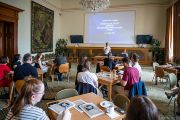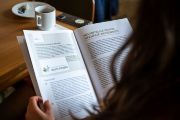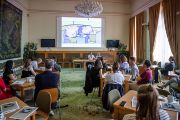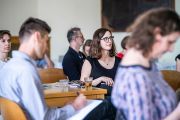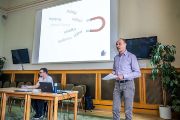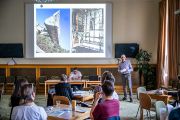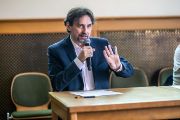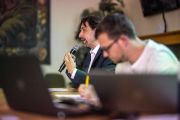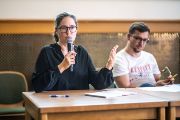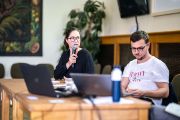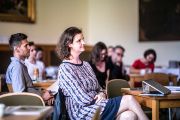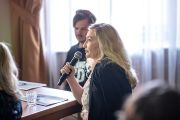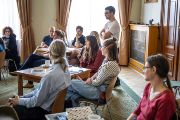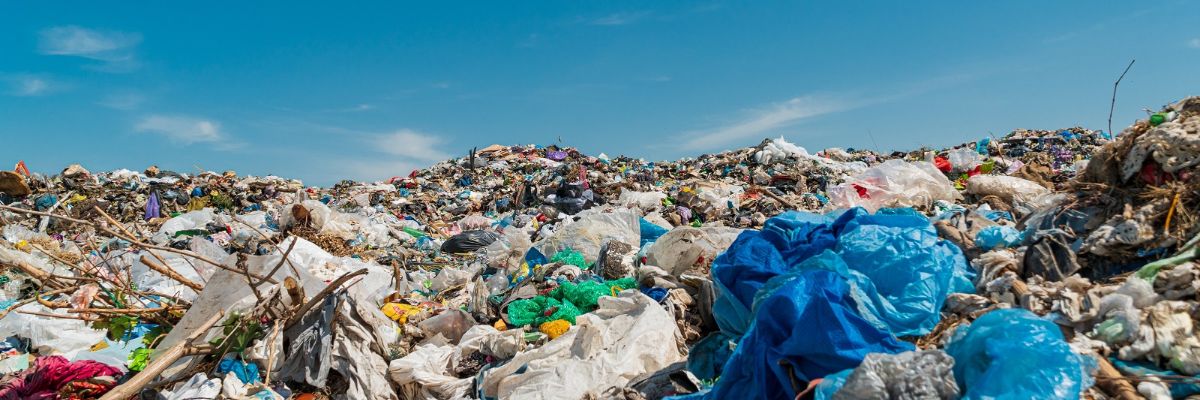
The hidden lives of waste: What can we learn from waste workers and pickers?
06. 05. 2025
Czech waste policy relies heavily on technical and economic solutions. We tend to view what ends up in the trash as a problem and a threat, particularly to the environment, or, conversely, as a business opportunity in the context of waste management. In other countries, however, there is a broader conversation underway, one that includes social and historical dimensions as well. A fresh perspective on the topic was offered at the seminar The Hidden Lives of Waste, held on 29 April 2025 at the Czech Academy of Sciences (CAS) headquarters on Národní Street in Prague.
Modern society is built on ever-increasing resource consumption. The sheer volume of waste being generated is a growing challenge across the globe. Though we try to sort our trash and recycle, much of it still fails to make it back into circulation. If anything, the opposite is true. The issue of toxic waste is escalating, and so is the export of hazardous materials to countries in Asia and Africa.
When it comes to designing measures for managing waste – or better yet, preventing it – it is important not only to consider technical and economic aspects, but also to integrate insights gained from a social-sciences perspective.
“Our experience of the COVID-19 pandemic is a good example of our [society’s] uncritical faith in the power of technical fixes. With waste, it’s the same story. If we believe that one day the problem will be solved by some miracle technology or a sophisticated economic model, we are unlikely to move forward as a society,” says anthropologist Daniel Sosna from the Institute of Ethnology of the CAS.
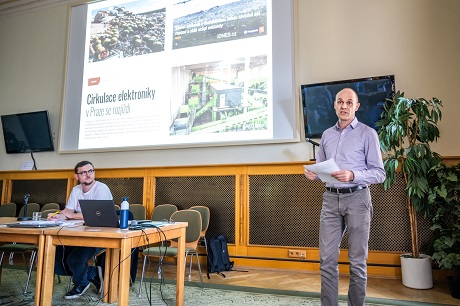
Anthropologist Daniel Sosna, presenting recommendations based on his long-term research on landfills at The Hidden Lives of Waste seminar.
Invisible people
One possible lens for examining the issue of waste is the anthropological perspective, which often makes use of participant observation. This method involves researchers embedding themselves in a community to better understand its activities and motivations. Daniel Sosna carried out fieldwork at two municipal waste landfills – conducting research for five years at one site (2012–2017) and three years at another (2020–2022). He conducted interviews with sanitation workers and landfill and sorting facility staff, but also with informal waste pickers who operate at or beyond the edge of legality.
According to Sosna, it would benefit the entire waste management system to engage more with these invisible actors. Workers with day-to-day experience of waste handling may, for instance, have valuable suggestions for improving collection sites and sorting centers. “Their experience receives very little attention. They’re at the bottom of this imagined hierarchy of stakeholders and, as a result, are not seen as significant holders of knowledge,” Sosna says.
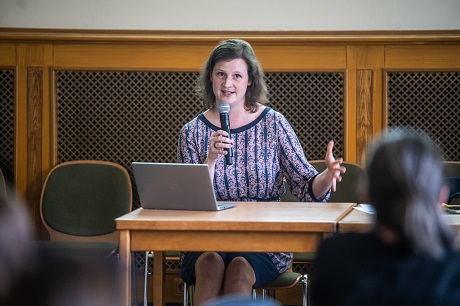
Zuzana Harmáčková from CzechGlobe – Global Change Research Institute of the CAS (pictured), Anna Uhnák Kárník from Zelený kruh, and Jiří Remr from the Institute for Evaluations and Social Analyses also contributed to the discussion.
Criminals or environmental stewards?
One of the more controversial ideas is the suggestion to also involve waste pickers who operate as part of the informal or gray economy and whose activities are currently classified as illegal. These are people who enter landfills to salvage items they deem still usable and then resell them. Other waste pickers extract pieces of metal – such as copper, aluminum, or iron – from the waste, which they can then cash in.
On the one hand, their actions can be seen as beneficial, since they manage to return materials to circulation that would otherwise end up buried in landfills or incinerated. On the other hand, in their quest for valuable metals extracted from cables, waste pickers sometimes burn off the plastic insulation, which can lead to fires and environmental pollution.
At the seminar at the Czech Academy of Sciences, several voices – including those of the Police of the Czech Republic – urged caution in decriminalizing these individuals. From their perspective, pickers often just relocate the waste: selling the metal and dumping the rest in forests or parks.
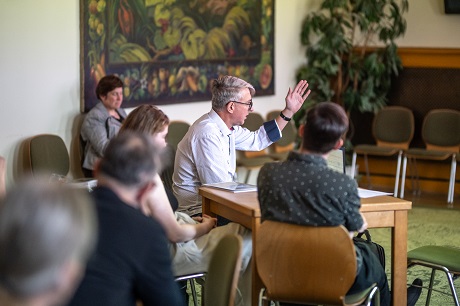
Jaromír Manhart from the State Environmental Fund of the Czech Republic opposed the idea of involving waste pickers (usually an illegal activity).
“Certain forms of gray economy could paradoxically benefit from being tolerated. We could prevent the creation of toxic burn sites and reduce the risk of fires near landfills by, for instance, providing accessible spaces equipped with tools for stripping cable insulation,” Sosna argues. In his view, repression leads nowhere.
He likened the situation to drug use. People simply cannot be banned from taking drugs; it’s more effective to create conditions that prevent them from endangering others. In the case of waste pickers, it’s also important to recognize that their livelihood is often passed down from one generation to the next – a kind of family “tradition.” Waste pickers don’t end up at landfills by accident.
“Repression just drives them to find new sources – often by damaging newly built infrastructure that contains metals. A more effective approach would be to exert some level of control over the informal scrap processing system,” the anthropologist says.
Recommendations for change
To broaden the debate around waste, the Technology Transfer Center of the CAS (CETAV), in cooperation with the Institute of Ethnology of the CAS, has produced a policy paper based on Daniel Sosna’s long-term research. The seminar at the Czech Academy of Sciences in April was a way to present these recommendations to the professional and broader public.
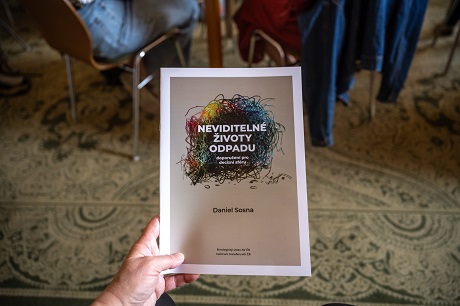
The Hidden Lives of Waste policy paper offers a concise selection of findings from Sosna’s anthropological research, including several concrete recommendations for lawmakers.
---
The policy paper is an example of how results from the social sciences and humanities can be translated into practice. To help clarify terminology and articulate goals in this area, the Czech Academy of Sciences has developed the Strategy for Knowledge Transfer and Valorization of the CAS with an Emphasis on the Potential of Social Sciences and the Humanities. You can learn more in an interview (in Czech) with CAS Vice-President Ondřej Beránek and representatives of the Technology Transfer Center of the CAS, Martin Smékal and Jan Mareš.
---
Written and prepared by: Leona Matušková, External Relations Division, CAO of the CAS
Translated by: Tereza Novická, External Relations Division, CAO of the CAS
Photo: Jana Plavec, External Relations Division, CAO of the CAS
 The text and photos are released for use under the Creative Commons license.
The text and photos are released for use under the Creative Commons license.
Read also
- Nine CAS researchers received the 2025 Praemium Academiae and Lumina Quaeruntur
- Step inside the world of research: Week of the Czech Academy of Sciences 2025
- A / Magazine: Bugs, the rusting human body, and beauties from the kingdom of ice
- PHOTO STORY: The invasive black bullhead catfish threatens Czech fishponds
- Rewrite the textbooks – we’ve found a bone; aka When science takes a wild turn
- CAS researchers receive L’Oréal-UNESCO Award and Forbes recognition
- Young scientists discussed economic challenges with Nobel laureates in Lindau
- A cure for cancer? Fighting the climate crisis? Ask the data scientists
- Vice-Presidents of the CAS set priorities for 2025–2029 term
- Public Hearing: “Making Sense of Open Science”
The Czech Academy of Sciences (the CAS)
The mission of the CAS
The primary mission of the CAS is to conduct research in a broad spectrum of natural, technical and social sciences as well as humanities. This research aims to advance progress of scientific knowledge at the international level, considering, however, the specific needs of the Czech society and the national culture.
President of the CAS
Prof. Eva Zažímalová has started her second term of office in May 2021. She is a respected scientist, and a Professor of Plant Anatomy and Physiology.
She is also a part of GCSA of the EU.
